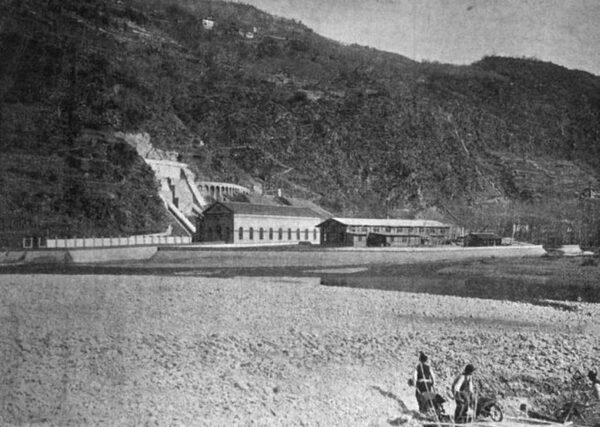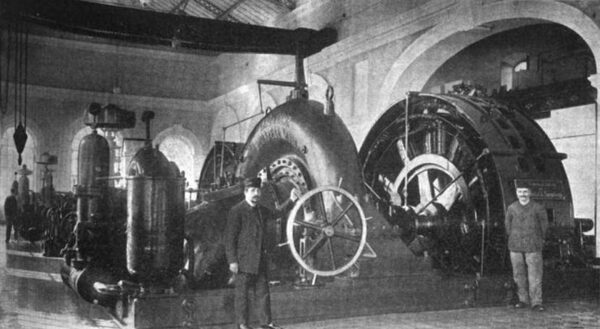[Trade Journal]
Publication: Elektrotechnische Zeitschrift
Wuppertal, Germany
p. 305-310, col. 1-3
The Valtellina high-voltage three-phase main line.
By Eugen Cserháti, Budapest.
Last autumn, the operation of the first electric main line system with high-voltage three-phase current was handed over to public transport. This is the so-called Valtellina line, which runs along the shores of Lake Como in northern Italy and was equipped with the high-voltage three-phase system by Ganz & Co. in Budapest.
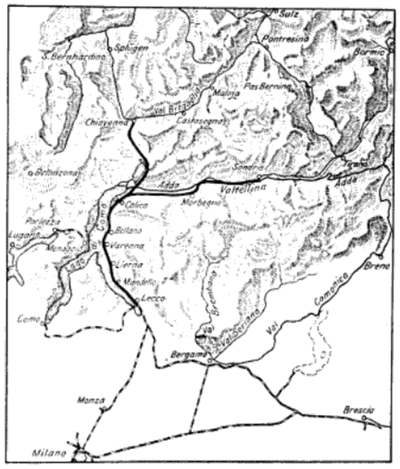 |
| Fig. 1 |
The choice of high-voltage three-phase current for main lines is based on the extremely significant quantitative differences that main lines face in comparison to tramways in terms of distances, speeds and train weights and which make the use of low voltage extremely difficult financially; however, if high voltage is to be used directly, then only three-phase current comes into consideration.
This system is described in more detail below. The situation of the Valtellina lines, as well as the length profiles of the line sections: Lecco If high voltage is to be used directly, only three-phase current comes into consideration.
It was therefore necessary to design a new system for traction. This task naturally required extensive tests, which on the one hand were to serve the use of a high voltage for traction purposes, which exceeded the previously usual voltage by several times, and on the other hand were intended to clarify the much-disputed question of whether three-phase motors in traction service allow an arrangement that is equivalent to direct current operation in economic terms.
| |||
| Fig. 5 |
| |||
| Fig. 6 |
Fig. 5 shows the external view of the central office, Fig. 6 the internal view.
Although successful tests had already been carried out with the use of three-phase current for traction purposes and the company mentioned above has also developed quite active activity in this direction since 1895, these tests were by no means of sufficient significance to allow further conclusions to be drawn on their basis.
For this reason, after the tests carried out in 1898 with the individual construction parts in the factory, in 1899 a 1 km long test track was built near Budapest on the Danube island of O-Buda and both the line material and the motor material for high-voltage three-phase current were tested on this during long test runs and the experience gained was used to improve and finally determine the installation location. The test results demonstrated the full suitability of the new traction system for practical use, the first example of which was the Valtellina railway, a large-scale test. It is the first electric main line where high-voltage three-phase current is used to transport large train units over long distances.
This system is described in more detail below.
The situation of the Valtellina lines, as well as the length profiles of the line sections: Lecco-Colico, 38.95 km, Colico-Sondrio, 40.19 km, Colico-Chiavenna, 26.57 km long, can be seen in Fig. 1, 2, 3, 4. The total length of the line is 106.31 km.
Primary lines.
From the power generation plant, the 20,000-volt primary current first reaches the Morbegno railway station. From here (Fig. 7) the line branches off with 3 pieces of 7mm diameter bare copper wires towards Sondrio as far as Castione, and on the other hand it is led with 3 pieces of 8mm diameter wires to Colico, where it divides again into two strands, each consisting of 3 pieces of 7mm diameter wires, whose transformer station is located next to Abbadia, the other one towards Lecco at km 20,350.
The primary lines are mounted on the other with 600 mm spacing between the wires (Fig. 15, 16). They are mounted on multi-layered porcelain insulators (Fig. 8) which are mounted on iron bolts. They can be divided into individual sections using the circuit breakers in the transformer stations. In addition, the Morbegno-Castione and Colico Chiavenna sections can be separated from the other lines using circuit breakers. Earth line resistors are mounted on the line masts.
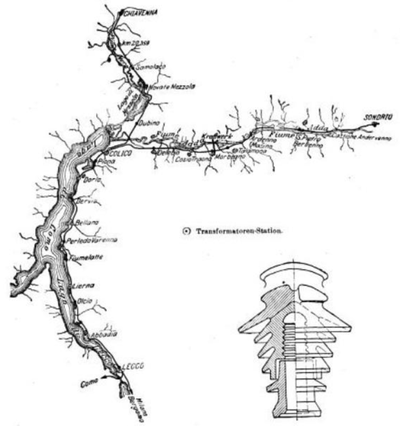 |
| Fig. 7-8 |
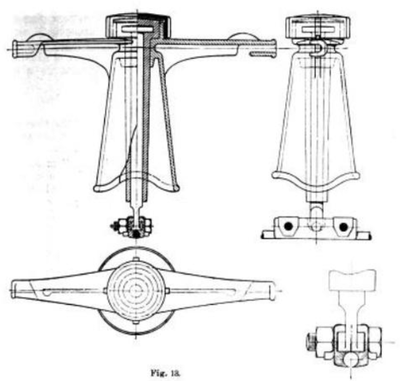 |
| Fig. 13 |
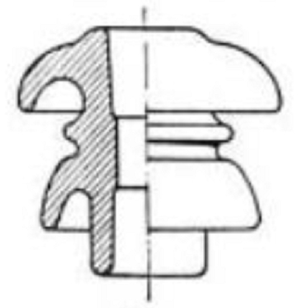 |
| Fig. 14 |
When the Societŕ Italiana per le Strade Ferrate Meridionali was asked by the Italian government to carry out tests for electric traction on main lines, the company found this line to be the most suitable to put the new system to the acid test of practical usability under the most difficult conditions. No less than 33% of the Lecco-Colico line is in tunnels. The line has a lot of gradients, up to 200%, about 50% of the line is in curves, the smallest radius of curvature of which is 300 m, in the switches 150 m.
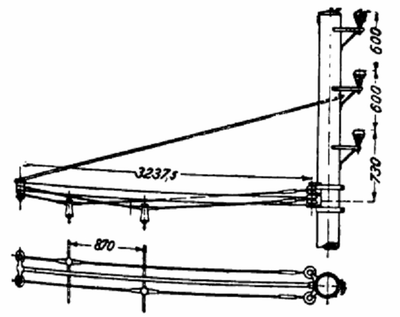 |
| Fig. 15 |
The Ambroin insulators are suspended by means of 5mm tinned steel wire on the porcelain insulators of a special shape attached on the other side (Fig. 14), two working wires are provided for the insulators on two special tension wires. Single-armed wooden poles are used to tension the lines in straight lines and insignificant curves (Fig. 15); in curves, wooden poles are used on both sides.
·
·

